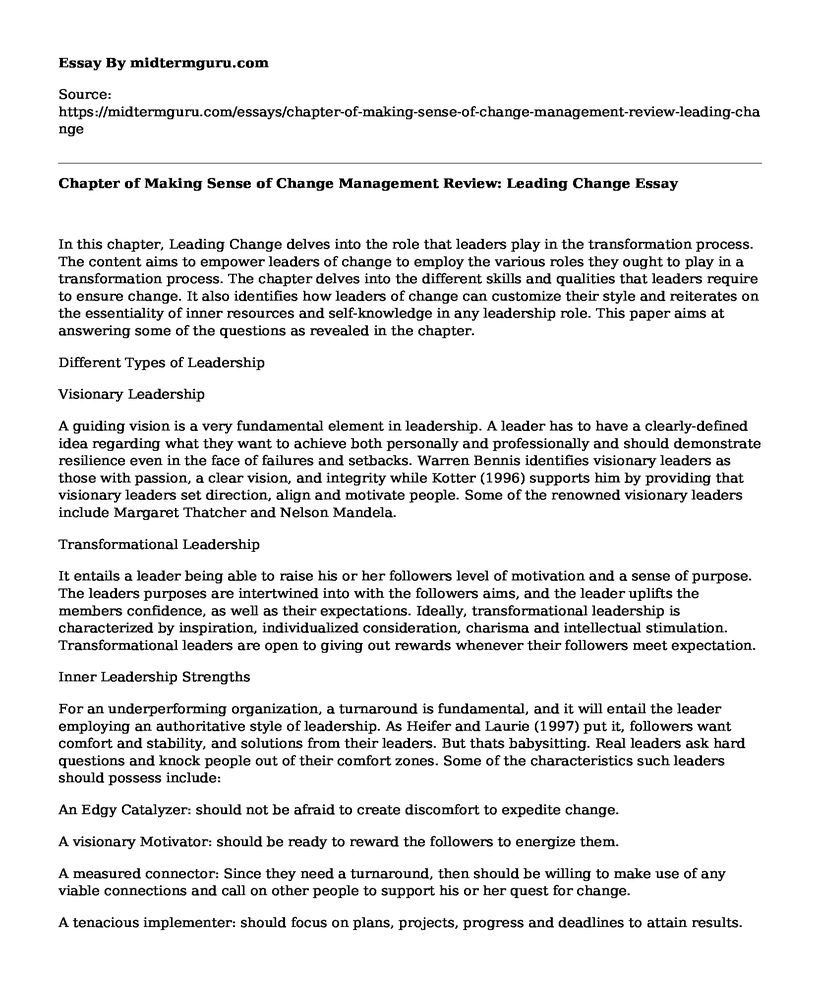In this chapter, Leading Change delves into the role that leaders play in the transformation process. The content aims to empower leaders of change to employ the various roles they ought to play in a transformation process. The chapter delves into the different skills and qualities that leaders require to ensure change. It also identifies how leaders of change can customize their style and reiterates on the essentiality of inner resources and self-knowledge in any leadership role. This paper aims at answering some of the questions as revealed in the chapter.
Different Types of Leadership
Visionary Leadership
A guiding vision is a very fundamental element in leadership. A leader has to have a clearly-defined idea regarding what they want to achieve both personally and professionally and should demonstrate resilience even in the face of failures and setbacks. Warren Bennis identifies visionary leaders as those with passion, a clear vision, and integrity while Kotter (1996) supports him by providing that visionary leaders set direction, align and motivate people. Some of the renowned visionary leaders include Margaret Thatcher and Nelson Mandela.
Transformational Leadership
It entails a leader being able to raise his or her followers level of motivation and a sense of purpose. The leaders purposes are intertwined into with the followers aims, and the leader uplifts the members confidence, as well as their expectations. Ideally, transformational leadership is characterized by inspiration, individualized consideration, charisma and intellectual stimulation. Transformational leaders are open to giving out rewards whenever their followers meet expectation.
Inner Leadership Strengths
For an underperforming organization, a turnaround is fundamental, and it will entail the leader employing an authoritative style of leadership. As Heifer and Laurie (1997) put it, followers want comfort and stability, and solutions from their leaders. But thats babysitting. Real leaders ask hard questions and knock people out of their comfort zones. Some of the characteristics such leaders should possess include:
An Edgy Catalyzer: should not be afraid to create discomfort to expedite change.
A visionary Motivator: should be ready to reward the followers to energize them.
A measured connector: Since they need a turnaround, then should be willing to make use of any viable connections and call on other people to support his or her quest for change.
A tenacious implementer: should focus on plans, projects, progress and deadlines to attain results.
A thoughtful architect: should focus on designs, frameworks and complex fit between concepts and strategies to ascertain that he or she affords a sound foundation to enable change.
Leadership using Coveys Seven Habits
Coveys seven habits teach leaders on how to be effective and lead themselves. It is all about the inside-out approach to leadership development. The seven habits include:
Be Proactive: As a leader, one should be at the forefront with clearly-defined objects and what ought to be done. Circumstances should not define a leaders motivation.
Begin with the end in mind: A leader should be visionary and set achievable objective with proper resources, tools, and skills in place. Set the team up for success right from the start.
Put first things first: Place much value on what is paramount over the urgent to avoid leading a crazy busy life.
Think win-win: Leaders should harbor interactions that are mutually beneficial.
Seek first to understand, then to be understood: Leaders should be open to understanding different personalities.
Synergize: Great leaders should value the contributions made by different people and understand whole is better that segments.
Sharpen the saw: Leader should take some time to renew themselves mentally, physically, socially or emotionally and spiritually.
The Things Managers Should do to Enable Transition
Establish the essentiality for change and a sense of urgency: this can be achieved through research, analysis, influence and internal assessment.
Create the change team: bring the right people on board including relevant expertise and discuss on the way forward.
Develop values, a strategy, and vision: Brainstorm on ideas and create a picture of what the future should look be.
Communicate the vision: ensure that it precise and clear enough and everybody on the team gets the message.
Empower and reward the team members: once the transitional phase is one, the manager should remain interested in the process but still entrust others and reward whenever the team meets expectation.
Consolidate and review: The managers should go through the review process, celebrate success and give positive feedback.
Reference
University of Phoenix. (2017). Making Sense of Change Management: A complete Guide to the Models, Tools and Techniques of Organizational Leadership.
Cite this page
Chapter of Making Sense of Change Management Review: Leading Change. (2021, May 28). Retrieved from https://midtermguru.com/essays/chapter-of-making-sense-of-change-management-review-leading-change
If you are the original author of this essay and no longer wish to have it published on the midtermguru.com website, please click below to request its removal:
- Potential Gains and Losses - Essay Sample
- Discussion Questions on Doctor of Nurse Practice as a Healthcare Leader - Paper Example
- Summarize Bass' Leadership Approaches - Paper Example
- Nurses' Managers: Leadership Styles & Job Satisfaction in Healthcare - Essay Sample
- Comparing Obama and Isocrates's Speech - Essay Sample
- Social Intelligence: The Key to Human Success - Essay Sample
- Leadership Qualities: The Key to Success in Any Organization - Essay Sample







